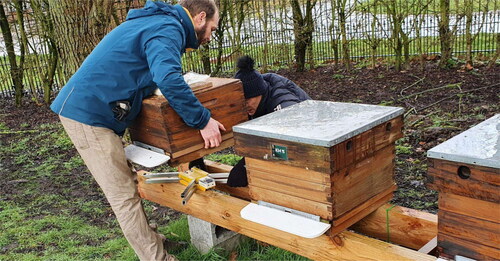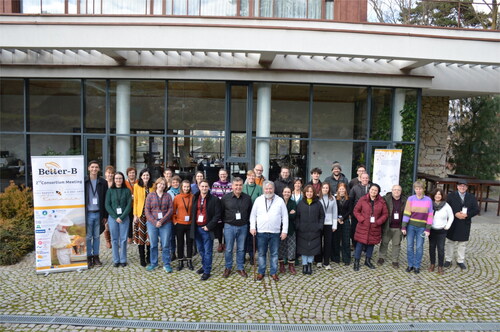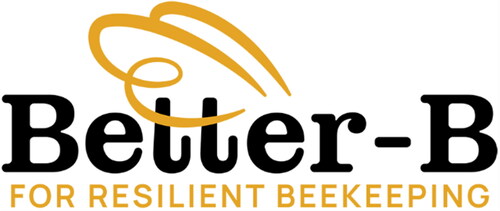The Better-B project is part of a diptych of projects selected within the framework of the European Union’s Horizon Europe funding and its 2022 call devoted to resilient beekeeping. The Better-B consortium consists of a multidisciplinary team of 16 partners and 2 associated partners from 14 countries. The project is coordinated by Professor Dirk de Graaf of Ghent University, Belgium. The project started on June 1, 2023 and will run for 48 months.
The project continues to build on the B-GOOD project, also funded by the EU, which was successfully completed at the end of 2023 with a focus on healthy and sustainable beekeeping. Some of the previous partners remained on board and new partners with specific expertise were added. Where we used hive monitoring systems in B-GOOD to estimate the health status of a colony based on automatically collected data (weight of the hive, internal temperature and sound), the intention is now to provide guidance to beekeepers in the context of selection work. The BEEP Foundation will now also supply the hive monitoring systems (the so-called BEEP bases) and offer the BEEP app logbook functionality, albeit as a subcontractor (and not as a partner as in B-GOOD).
Photo 2. The hive monitoring system BEEP base was placed under the hive at the apiary of Ghent University in Merendree, Belgium.

The Better-B project works around a central idea that honey bees in nature live in more harmony and balance than colonies from intensive beekeeping. Inspired by the work of Dr. Tjeerd Blacquière (Blacquière et al., Citation2019) with his Darwinian Black Box and the situation of honey bees in Africa, where natural selection has led to resilient honey bees (Gebremedhn et al., Citation2019), the Better-B consortium wants to tailor modern beekeeping more to what is happening in nature. It was worded as follows in the project proposal ‘The key to resilient beekeeping is to harness the power of nature to restore harmony and balance inside the honey bee colony and between the colony and the environment.’
The first work package (WP) focuses on the carrying capacity of the landscape and the competition between honey bees and wild bees. Work continues on B-GOOD's dynamic food resources model, which calculates how much food honey bees can collect in a certain habitat based on its specific characteristics (the bee-friendly plants that grow there and their plant phenology). Citizen scientists will be used to validate the data on the flowering period of the various bee-friendly plants and to count the flower visits by honey bees and other pollinators. The final goal is to develop a tool that allows us to calculate the optimal density of beehives for a given landscape, both to prevent food shortages among honey bees, but also to minimize competition with wild bees.
The second work package is about resilience to chemicals. In the first part, we want to determine in a field experiment that extends over a gradient of ecosystem complexity, to what extent that environment determines the resilience of the population against pesticide exposure. In a second part, we want to investigate to what extent exposure to pesticides has caused a selection pressure to which the receptors of these pesticides have adapted. The aim is to map the found point mutations (SNPs, Single Nucleotide Polymorphisms) in the corresponding receptors and to determine their effect on the electrophysiological properties of that receptor. A rapid laboratory test (TaqMan assay) will be developed for the most interesting SNPs to detect them in a targeted manner. It can allow us to quickly detect bee colonies with an innate resistance to some pesticides in the population, but also to map the historical pesticide pressure.
WP3 is about resilience against climate and heat stress. Here we ask ourselves whether we can recognize a certain signature in the honey bee genome that points to climatic adaptation. For this purpose, honey bees are collected along the north-south axis of Europe. In addition, we will experimentally determine the critical temperature limits (CTmax/CTmin) for different populations. We make hybrids from the colonies with the extreme values by mating. In the drones of the second filialis you then get the segregation of the responsible alleles, which we then will identify through genome sequencing and an association study. Furthermore, this work package also looks at the microclimate in the bee hive and how we can improve it by using other materials and coatings in the construction.
WP4 focuses on the Darwinian Black Box, a new method of selection in which we give natural selection a chance without allowing non-adapted kolonies to wither away (Blacquière et al., Citation2019). We will monitor a number of established Darwinian colonies in the Netherlands, Romania and Norway, but we will also roll out this new breeding program in countries where this has not yet happened before. In addition, we also look for characteristic genome signatures here and test whether hive monitoring systems are able to identify the adapted colonies. We also envision an experiment in which bee colonies are exchanged along the north-south axis and the east-west axis to see to what extent local adaptation is lost.
A branch of immunity that is hardly studied nowadays will receive new impetus in the 5th work package on immune resilience. Indeed, we are going to re-consider the nomenclature of the blood cells of the honey bee on the basis of surface determinants. For this purpose, these surface determinants are removed enzymatically from hemocytes and identified in a proteomic approach. This should make it possible to develop antibodies for flow cytometric characterization of the blood count.
In the latest research-oriented work package we look ahead to the future of beekeeping in Europe and try to arm ourselves against global warming and invasive pest species such as the small hive beetle, the Asian hornet and the Tropilaelaps mite. An illustrated manual for better construction of beehives will be published. We will perform a risk assessment study of the three pest species mentioned above and a contingency plan in case they would invade our territory. For Tropilaelaps this means, among other things, the development of a rapid laboratory test for confirmation. We also want to encourage the implementation of the so-called Integrated Pest Management in apiculture, by offering an online tool that determines the most appropriate strategy for the user (the beekeeper). Finally, we want to reduce stress caused by beekeepers’ interventions by focusing on low-stress beekeeping practices.
It should be clear: Better-B is an ambitious project that will target many facets of resilient beekeeping with the aim of better arming the honey bee against different (especially abiotic) stressors. The project works according to the multi-actor approach in which the actors of the beekeeping value chain are involved from the start in the creation and implementation of the project. If you want to know more about Better-B and interact with our researchers, be sure to visit our website (https://www.better-b.eu/) and register for the multi-actor forum.
Disclosure Statement
No potential conflict of interest was reported by the author.
Additional information
Funding
References
- Blacquière, T., Boot, W., Calis, J., Moro, A., Neumann, P., & Panziera, D. (2019). Darwinian black box selection for resistance to settled invasive Varroa destructor parasites in honey bees. Biological Invasions, 21(8), 2519–2528. https://doi.org/10.1007/s10530-019-02001-0
- Gebremedhn, H., Amssalu, B. ; D., Smet, L., & de Graaf, D. C. (2019). Factors restraining the population growth of Varroa destructor in Ethiopian honey bees (Apis mellifera simensis). PLoS One, 14(9), e0223236. https://doi.org/10.1371/journal.pone.0223236



